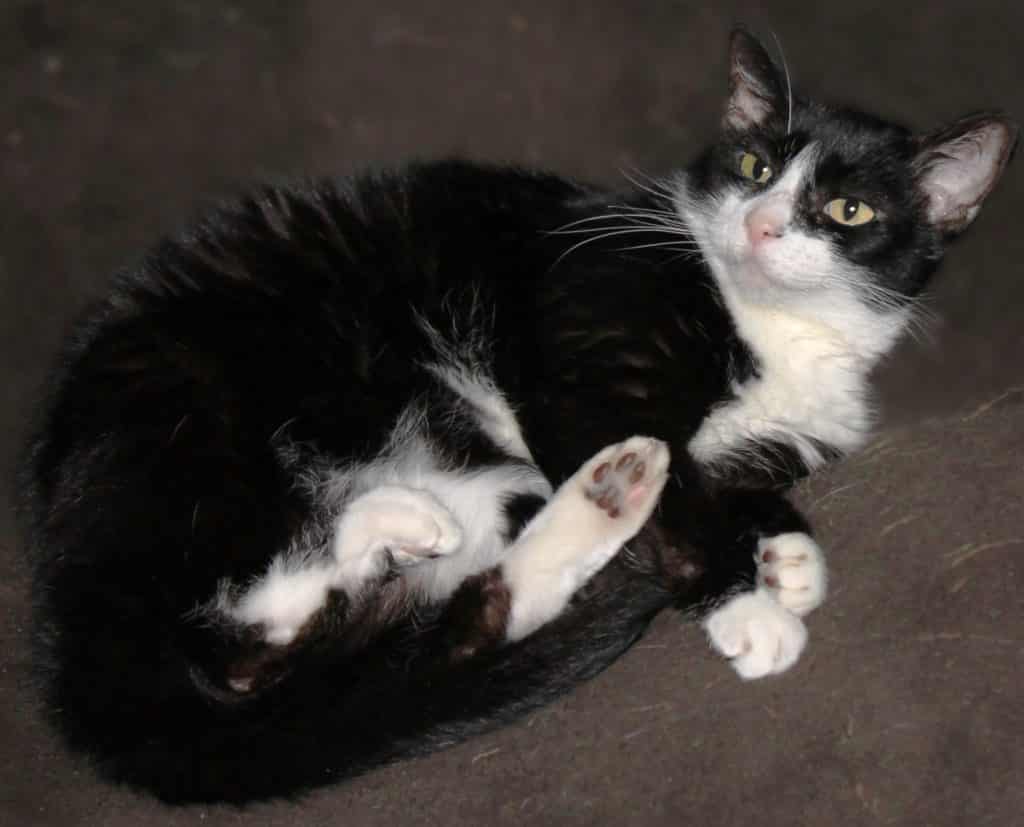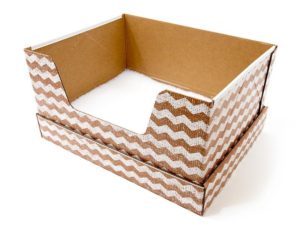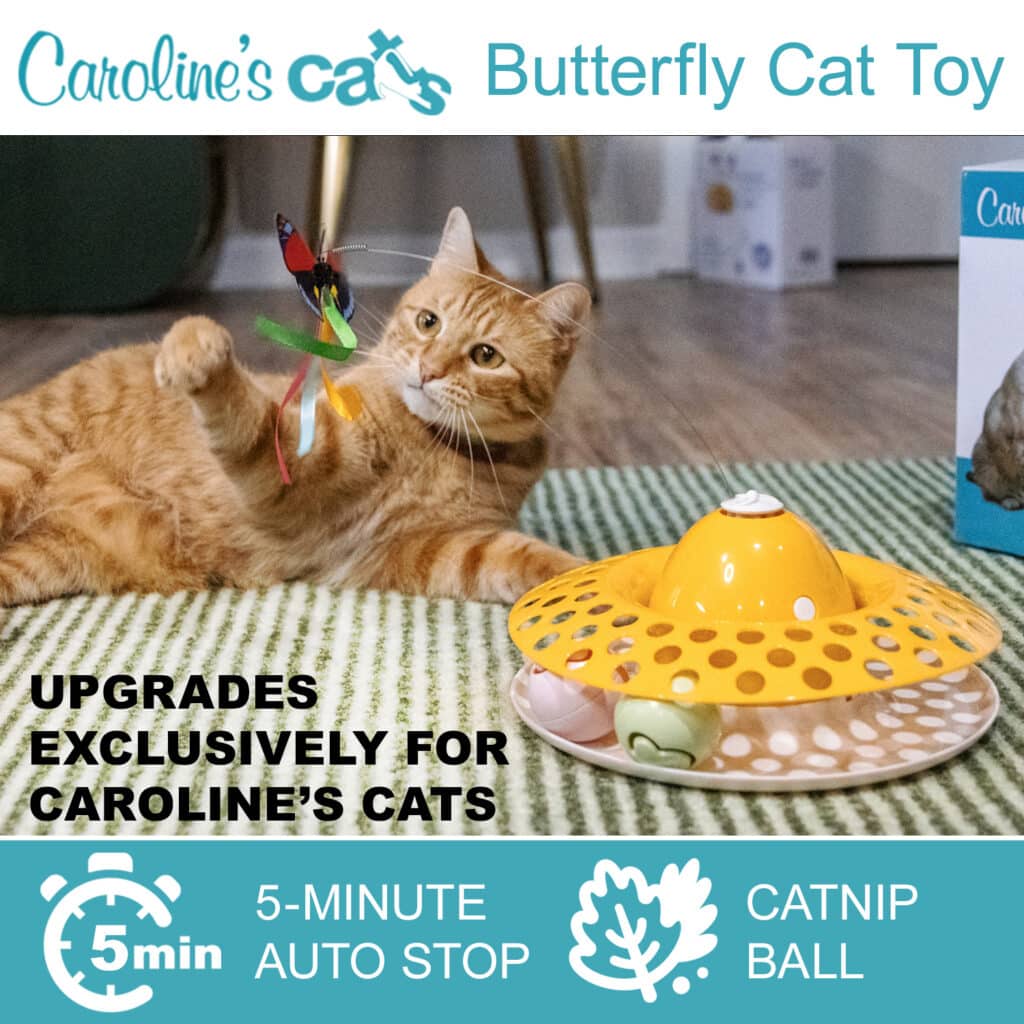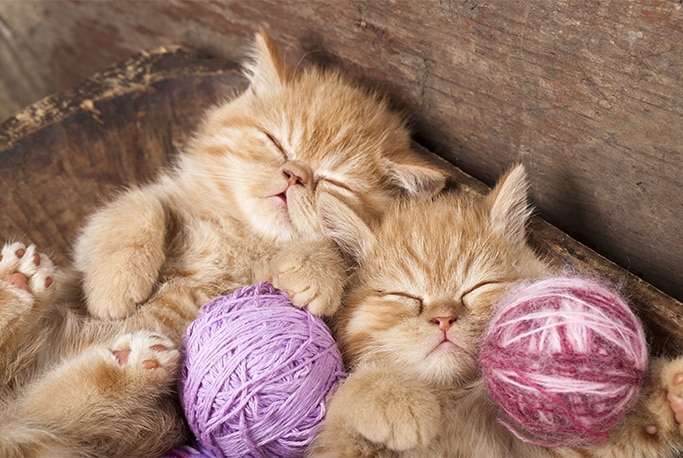If you’re thinking about adopting a new cat or you’ve already committed to taking home that little kitten, here’s a kitten and cat adoption checklist to help you get the items you need. Each item is explained in detail below this quick bulleted list.
Cat Adoption Checklist: Things You Need When Adopting a Kitten or Cat
- Veterinarian / Exam and Vaccinations
- Food / Water and Cat Dishes
- Cat Carrier
- Litter Box
- Cat / Kitten Toys
- Cat Bed
In 2002 I adopted a cat from a no-kill shelter. Nothing particularly unusual about that except at the time I was completely unprepared.
I had been a cat parent before, but my furry children were with my ex at the time. Furthermore, they were outdoor cats — I had never had an indoor only cat before.
I had just received a disturbing medical diagnosis, and I found myself at the no-kill shelter looking at cats. The cat who chose me, Tina, was free to adopt because she had a health problem that made people reluctant to adopt her. I immediately said I would take her and asked them to hold her so I could go out and get the things I would need once I brought her home. I wish I had had a cat adoption checklist like this one to make sure I had everything I needed.

Everything turned out fine, and this special cat lived with me through moves and life changes for 14 years until I had to help her cross the rainbow bridge in the summer of 2016.
Adopting a cat or kitten can be something you’ve carefully planned for weeks or months, or it can be something spontaneous. I believe either is fine as long as you realize that it’s a lifetime commitment.
Whether you’re carefully planning your adoption, or you suddenly find yourself with a new kitten or cat, here is a cat adoption checklist of the most important things you will need for your new kitty.
1. Veterinarian / Exam and Vaccinations
First on our cat adoption checklist: shots for your new kitten are super important even if you plan for your fur baby to be an indoor-only cat.
But wait. How can my cat be exposed to communicable diseases if I don’t let him outside and he doesn’t come into contact with other cats.
Here’s why: you go in and out of your house. Yes, you can carry diseases inside your home to your kitten.
Let’s say you walk out to your mailbox. You don’t know this, but last night a stray cat with distemper (Panleukopenia) walked through your yard and rubbed on (marked) your mailbox post. You can pick up the virus and carry it inside to your kitten.
Also, inside cats sometimes slip out a door or window and can be exposed to all kinds of nasty germs before you get them safely back home.
If you adopted your kitten from a pet shop or a shelter, they will most likely have already received their first set of vaccinations. They should provide you documentation of the shots that you can take to your new vet. If you don’t see an immunization record in your adoption paperwork, be sure to ask about it. Even if your kitten has received her first shots, she will soon need a second round of vaccinations. This can be time-sensitive, so be sure to make a vet appointment as soon as possible.
If your new kitten was a stray or adopted from a friend, make a vet appointment right away to get your kitten vaccinated.
When To Get Your Kitten’s Vaccinations:
Your kitten needs feline distemper boosters every three weeks until over 14 weeks of age, feline leukemia vaccinations at 9 and 12 weeks of age, and a rabies vaccination at 12 weeks of age.
Your vet will also check your kitten for internal and external parasites such as worms and fleas. You vet will treat your kitten for these creepy crawlies if necessary.
You’ll also want to talk to your vet about spaying or neutering your kitten. This should be done around 6 months of age. In addition to curbing the pet population, spaying or neutering your kitten can prevent unwanted spraying and marking. It also makes your indoor cat less likely to run outside. Hormonal urges to mate will override the safety of your home every time. Unneutered cats are also susceptible to illnesses contracted through mating or fighting.
Keep your kitten healthy with regular vet visits and preventative treatment.
2. Food / Dishes for Water and Food
Okay, this probably goes without saying. You’ll need to get kitten food and containers for your kitten’s food and water. This is the most important item on our cat adoption checklist.
Of course, you could use your own human bowls and plates to feed your new kitten. However, you might soon discover that your energetic kitten will easily spill these and possible break your dishes.
Containers with sturdy bottoms designed to not tip over are recommended for your kitten’s food and water.
Make sure that water is always available and easily accessible. You can also find cat fountains that provide circulating, aerated water for your kitten.
You can set up a feeding schedule for your kitten or make dry food always available and allow your kitten to free-feed. If food is always available, your kitten will only eat when she is hungry and is not likely to develop overeating habits.
Be sure to choose a high-quality kitten food because your kitten requires extra protein, fat, vitamins, and minerals while she is growing. Your kitten’s first six months are especially important for muscle, bone, and nervous system development. You should provide food specially formulated for kittens until around one year of age.
3. Cat Carrier
Sure, your kitten is small now and might be easy to transport by just holding her in your lap.
However, your new kitten won’t always be this small and easy to handle. Also, he might be scared of unfamiliar settings and may hide under your car seat or in some other inconvenient or inaccessible area.
This is why a quality cat carrier is also an important item on our cat adoption checklist.
Get something sturdy that will last for many years. You’ll need it for vet visits and to transport your cat to a boarding facility if you’re going out of town.
Your kitten will be most comfortable when the carrier is lined with a soft towel or an old shirt with your scent on it. Continue reading this cat adoption checklist to find our what else you need.
4. Litter Box

Using a litter box is natural for a kitten. It’s instinctive for them to want to bury their “business,” and they will usually dig in the litter before they go.
To prevent your kitten from scattering litter throughout the house, be sure the litter box has plenty of room for him to turn around. (Also keep in mind that he is going to grow!) You might also want a mat to place under the box to collect litter that gets stuck to your kitten’s paws.
Fill the box with the litter of your choice. Unscented clumping litter is often preferable to other types of litter. Get a litter scoop and clean the litter daily. Empty and wash the litter box once a week. Use a mild cleanser like diluted bleach at least once per month.
5. Kitten / Cat Toys
Toys are important for a kitten’s physical and mental development.
Mother cats start teaching their kittens to hunt when they are about 6 weeks old. The mother cat will first bring dead prey home to the kittens and let them play with it prior to eating it. From this, the kitten graduates to prey that is still alive but not very mobile. Finally, the mother will bring home live, healthy prey for the kittens to “hunt.”
Toys that mimic this hunting behavior are best for your kitten. Your kitten will entertain herself by throwing around toy mice or batting around small balls.
Automatic cat toy are also great for engaging your kitten. This butterfly cat toy is one of the best.
Cat toys are important for bonding with your kitten.

You can also bond with your kitten with interactive toys such as snakes or feathers attached to wands that you can pull around for your kitten to chase. Cats are intelligent animals and your kitten will soon realize that you are controlling the toy. This doesn’t detract from the fun, however, as he will begin “asking” you to play with him using the toy.
Laser pointers are also great fun, and your kitten will love chasing the red dot. Some cats never fully understand where the dot is coming from, but the most intelligent cats will figure out that you are controlling the dot. I have one cat that actually goes to the laser pointer and bats at it when she wants to play with it.
Play with your cat to help her sleep.
If you’re having trouble getting your kitten or cat to go to sleep at night, play with her then feed her. In the “wild,” cats hunt, eat their prey, then sleep. If you play with your kitten and allow him to catch the prey then give him a meal, he will be ready to go to sleep.
Choose the right cat toys.
Choose toys that cannot be torn apart and swallowed. Never give your kitten toys like balls of yarn or spools of thread, wire twist ties, rubber bands or corks, or balls of cellophane or aluminum foil. Don’t give your kitten breakable objects like Christmas ornaments.
Although cats are less likely to eat objects than dogs, they can still be harmed by swallowing small items.
There are tons of cat toys on the market, and different kittens respond to different types of toys. Some will even prefer pieces of trash over expensive toys. You’ll need to experiment and purchase cat toys appropriate for your kitten.
See reviews of cat toys in our review section.
6. Cat Bed
Last but not least on our cat adoption checklist: a good cat bed.
Cats can sleep almost anywhere. That being said, you new kitten will feel safer if you provide him with a warm, safe bed. If the kitten is very young, he will prefer a place that he can “hide” so that he feels safe until he’s used to his new home. An enclosed cat bed is ideal for your little fur ball.
There are a wide selection of enclosed beds on the market. Any of these should be suitable. Place an old shirt or something with your scent on it in the bed so your kitten can get accustomed to you.
You could also cut a hole in a box and place bedding inside for your kitten.
Place the bed in a quiet corner of your home away from noise and traffic.
As your kitten grows, she will let you know her sleeping preferences and you can purchase bedding accordingly.
7. Scratching Post
Scratching is a natural behavior for cats. They do it to stretch, remove dead scales from their claws, and to mark their territory.
Provide your kitten with a scratching post tall enough for her to get a good stretch. (Remember, she will grow!) Encourage her to scratch the post and redirect her if you catch her using her claws on her furniture.
Cats like to stretch when they wake up, so place the scratching post close to your kitten’s bedding so it is readily available for her. Play with her around it or drag her favorite toy across it. If she doesn’t like the post, try something with a different texture. There are many different scratching posts and pads available. She might like sisal, or you may find she prefers to scratch bare wood or corrugated board. Bring home different kinds of scratchers until you discover which she prefers. Then buy several of these and distribute them throughout your home.
I hope you found this cat adoption checklist helpful and perhaps entertaining. Please consider joining our mailing list and we will keep you up-to-date on cat-related topics.




